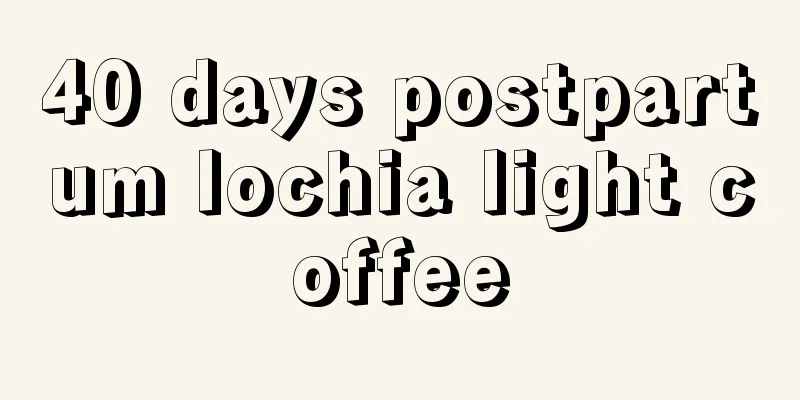40 days postpartum lochia light coffee

|
Is it normal to have brown lochia 40 days after giving birth? The discharge of lochia during pregnancy is considered an important part of the body's transformation after giving birth, but many new mothers still seem ignorant about how to deal with the problem of lochia during pregnancy. Next, let us learn about the relevant knowledge of postpartum lochia. Is it normal to have brown lochia 40 days after giving birth? Because the health conditions of each pregnant woman are different, the amount and duration of postpartum lochia will also be different. Generally, the lochia will stop 3 to 4 weeks after giving birth. If it continues to drip for more than three weeks, it may be that the lochia is not clear. It is best to go to the hospital for medical treatment immediately to avoid delaying the condition. It is very necessary for female friends to learn more about postpartum lochia in order to be prepared. Below we discuss how the color of postpartum lochia changes. The first stage is 3-6 days after giving birth. Because the lochia contains more blood, just like most of the menstrual period is blood and uterine wall tissue, it is bright red and is called stubborn lochia. The second stage is 7-14 days after giving birth. During this period, the lochia contains less blood and is mainly composed of necrotic decidual tissue and mucus. It looks more and more like serous fluid, so it is light pink and is called serous lochia. The third stage is 2-3 weeks after giving birth. There should be only a small amount of milky white or yellowish secretion. The lochia contains a lot of white blood cells, epidermal cells and some decidual tissue, which is milky white and is called white lochia. What should I do if lochia recurs after childbirth ? 1. Pregnant women should actively treat various pregnancy diseases before giving birth, such as pregnancy-induced hypertension syndrome, anemia, vaginitis, etc. 2. For patients with placental abruption and elderly people during delivery, give antibiotics to prevent infection. 3. After giving birth, pregnant women should carefully check whether the embryo and fetal membrane are completely gone, and if there are any residues, they should be properly handled. Check the fetal membrane and flatten the embryo with the mother facing upwards. Note whether the leaves are aligned and whether there is any damage. Then the fetal membrane is lifted up to check whether it is intact, and at the same time pay attention to whether there are abnormal blood vessels passing through the fetal membrane. If there are broken blood vessels, it means that there may be "accessory placenta" remaining in the uterine cavity. If the embryo is incomplete or most of the fetal membrane remains, it must be removed by hand or with instruments into the uterine cavity under strict disinfection to prevent postpartum hemorrhage or infection. If a small portion of the fetal membrane remains, uterine contractions can be used after delivery to promote its natural expulsion. 4. Persistent breastfeeding is beneficial to uterine contraction and the discharge of postpartum lochia. 5. Observe the color, amount and smell of postpartum lochia every day after delivery. Normal postpartum lochia should have no peculiar smell but contain a fishy smell. If a peculiar smell is found, it may be that there are fetal remains in the uterus and should be treated immediately. 6. Measure the degree of uterine contraction regularly and accurately. If you find that the contraction is poor, you should see a doctor and take new uterine contraction drugs. 7. Maintain vaginal cleanliness. Because of the postpartum lochia discharge, women must change sanitary napkins frequently to keep them fresh. It is best to temporarily refrain from having sex to prevent infection. 8. If the mother has continuous lochia and suspects that there is placenta residue, she should go to the hospital immediately and receive treatment under the guidance of a doctor. |
<<: 40 days after delivery, the lochia is yellow
>>: How to tell if you have your period 46 days after giving birth
Recommend
Can I drink coffee during menstruation?
It is best not to drink more than three cups of c...
Marin Software: The highest click-through rate of smartphone top ads reached 39%
199IT original compilation We all know the impact...
Can pregnant women smell yellow orchid?
Some people really like to smell the scent of flo...
Can I still get the cervical cancer vaccine at the age of 48?
Everyone knows about the cervical cancer vaccine,...
Is eating too much pork bad for you? Which is healthier, red meat or white meat? Huaxi doctors: Remember these 3 points when eating meat!
Meat-loving friends Have you heard of red meat an...
Does egg retrieval without anesthesia increase the success rate?
I believe that women who have experienced artific...
How to reduce pelvic inflammatory disease during menstruation
Pelvic inflammatory disease is a relatively commo...
High prolactin diet therapy
If prolactin is too high, patients should never i...
Why do I feel nauseous and want to vomit when I have my period?
Many girls may experience nausea and vomiting dur...
Deloitte Consulting: 2018 China Mobile Consumer Research Report
Today, Deloitte China's core service team for...
Itchy vagina during menstruation
Nowadays, family conditions are generally better ...
The more you scratch, the more itchy it becomes. The more itchy it becomes, the more you scratch... Where does our "itchiness" come from?
Today we are going to talk about why you itch. Th...
The body accumulates mutations throughout life. Could this be the cause of aging?
Imagine your body, a mosaic of cells with thousan...
Does yellow lochia mean it's time to get rid of it?
After giving birth, a woman's body will disch...
Irregular menstruation
Irregular menstruation is a physical disease that...









